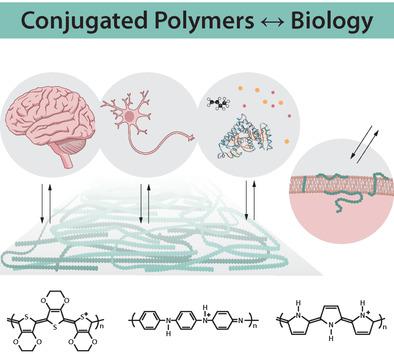当前位置:
X-MOL 学术
›
Adv. Mater.
›
论文详情
Our official English website, www.x-mol.net, welcomes your
feedback! (Note: you will need to create a separate account there.)
Conjugated Polymers for Assessing and Controlling Biological Functions
Advanced Materials ( IF 27.4 ) Pub Date : 2019-03-12 , DOI: 10.1002/adma.201806712 Erica Zeglio 1, 2 , Alexandra L. Rutz 3 , Thomas E. Winkler 2 , George G. Malliaras 3 , Anna Herland 2, 4
Advanced Materials ( IF 27.4 ) Pub Date : 2019-03-12 , DOI: 10.1002/adma.201806712 Erica Zeglio 1, 2 , Alexandra L. Rutz 3 , Thomas E. Winkler 2 , George G. Malliaras 3 , Anna Herland 2, 4
Affiliation

|
The field of organic bioelectronics is advancing rapidly in the development of materials and devices to precisely monitor and control biological signals. Electronics and biology can interact on multiple levels: organs, complex tissues, cells, cell membranes, proteins, and even small molecules. Compared to traditional electronic materials such as metals and inorganic semiconductors, conjugated polymers (CPs) have several key advantages for biological interactions: tunable physiochemical properties, adjustable form factors, and mixed conductivity (ionic and electronic). Herein, the use of CPs in five biologically oriented research topics, electrophysiology, tissue engineering, drug release, biosensing, and molecular bioelectronics, is discussed. In electrophysiology, implantable devices with CP coating or CP‐only electrodes are showing improvements in signal performance and tissue interfaces. CP‐based scaffolds supply highly favorable static or even dynamic interfaces for tissue engineering. CPs also enable delivery of drugs through a variety of mechanisms and form factors. For biosensing, CPs offer new possibilities to incorporate biological sensing elements in a conducting matrix. Molecular bioelectronics is today used to incorporate (opto)electronic functions in living tissue. Under each topic, the limits of the utility of CPs are discussed and, overall, the major challenges toward implementation of CPs and their devices to real‐world applications are highlighted.
中文翻译:

用于评估和控制生物功能的共轭聚合物
在精确监测和控制生物信号的材料和设备的开发中,有机生物电子学领域正在迅速发展。电子和生物学可以在多个层面上相互作用:器官,复杂组织,细胞,细胞膜,蛋白质,甚至是小分子。与诸如金属和无机半导体之类的传统电子材料相比,共轭聚合物(CP)在生物相互作用方面具有几个关键优势:可调节的理化性质,可调节的形状因数以及混合的电导率(离子和电子)。在此,讨论了CP在五个面向生物学的研究主题(电生理学,组织工程,药物释放,生物传感和分子生物电子学)中的使用。在电生理学方面,具有CP涂层或仅CP电极的可植入设备在信号性能和组织界面方面显示出改善。基于CP的支架为组织工程提供了非常有利的静态甚至动态接口。CP还可以通过多种机制和形式因素来输送药物。对于生物传感,CP提供了将生物传感元件整合到导电基质中的新可能性。如今,分子生物电子学已被用于在活体组织中整合(光电)电子功能。在每个主题下,都讨论了CP实用程序的局限性,总的来说,突出了实现CP及其设备到实际应用中的主要挑战。CP还可以通过多种机制和形式因素来输送药物。对于生物传感,CP提供了将生物传感元件整合到导电基质中的新可能性。如今,分子生物电子学已被用于在活体组织中整合(光电)电子功能。在每个主题下,都讨论了CP实用程序的局限性,总的来说,突出了实现CP及其设备到实际应用中的主要挑战。CP还可以通过多种机制和形式因素来输送药物。对于生物传感,CP提供了将生物传感元件整合到导电基质中的新可能性。如今,分子生物电子学被用于在活体组织中整合(光电)电子功能。在每个主题下,都讨论了CP实用程序的局限性,总的来说,突出了实现CP及其设备到实际应用中的主要挑战。
更新日期:2019-03-12
中文翻译:

用于评估和控制生物功能的共轭聚合物
在精确监测和控制生物信号的材料和设备的开发中,有机生物电子学领域正在迅速发展。电子和生物学可以在多个层面上相互作用:器官,复杂组织,细胞,细胞膜,蛋白质,甚至是小分子。与诸如金属和无机半导体之类的传统电子材料相比,共轭聚合物(CP)在生物相互作用方面具有几个关键优势:可调节的理化性质,可调节的形状因数以及混合的电导率(离子和电子)。在此,讨论了CP在五个面向生物学的研究主题(电生理学,组织工程,药物释放,生物传感和分子生物电子学)中的使用。在电生理学方面,具有CP涂层或仅CP电极的可植入设备在信号性能和组织界面方面显示出改善。基于CP的支架为组织工程提供了非常有利的静态甚至动态接口。CP还可以通过多种机制和形式因素来输送药物。对于生物传感,CP提供了将生物传感元件整合到导电基质中的新可能性。如今,分子生物电子学已被用于在活体组织中整合(光电)电子功能。在每个主题下,都讨论了CP实用程序的局限性,总的来说,突出了实现CP及其设备到实际应用中的主要挑战。CP还可以通过多种机制和形式因素来输送药物。对于生物传感,CP提供了将生物传感元件整合到导电基质中的新可能性。如今,分子生物电子学已被用于在活体组织中整合(光电)电子功能。在每个主题下,都讨论了CP实用程序的局限性,总的来说,突出了实现CP及其设备到实际应用中的主要挑战。CP还可以通过多种机制和形式因素来输送药物。对于生物传感,CP提供了将生物传感元件整合到导电基质中的新可能性。如今,分子生物电子学被用于在活体组织中整合(光电)电子功能。在每个主题下,都讨论了CP实用程序的局限性,总的来说,突出了实现CP及其设备到实际应用中的主要挑战。































 京公网安备 11010802027423号
京公网安备 11010802027423号